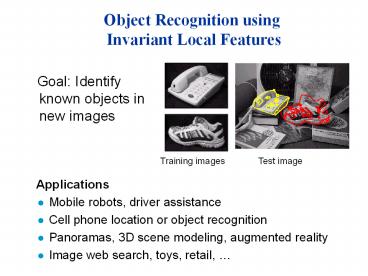Object Recognition using Invariant Local Features - PowerPoint PPT Presentation
Title:
Object Recognition using Invariant Local Features
Description:
Cell phone location or object recognition. Panoramas, 3D scene ... (b) 832 DOG extrema (c) 729 left after peak. value threshold (d) 536 left after testing ... – PowerPoint PPT presentation
Number of Views:93
Avg rating:3.0/5.0
Title: Object Recognition using Invariant Local Features
1
Object Recognition using Invariant Local Features
Goal Identify known objects in new images
Training images Test image
- Applications
- Mobile robots, driver assistance
- Cell phone location or object recognition
- Panoramas, 3D scene modeling, augmented reality
- Image web search, toys, retail,
2
Local feature matchingTorr Murray (93) Zhang,
Deriche, Faugeras, Luong (95)
- Apply Harris corner detector
- Match points by correlating only at corner points
- Derive epipolar alignment using robust
least-squares
3
Rotation InvarianceCordelia Schmid Roger Mohr
(97)
- Apply Harris corner detector
- Use rotational invariants at corner points
- However, not scale invariant. Sensitive to
viewpoint and illumination change.
4
Scale-Invariant Local Features
- Image content is transformed into local feature
coordinates that are invariant to translation,
rotation, scale, and other imaging parameters
SIFT Features
5
Advantages of invariant local features
- Locality features are local, so robust to
occlusion and clutter (no prior segmentation) - Distinctiveness individual features can be
matched to a large database of objects - Quantity many features can be generated for even
small objects - Efficiency close to real-time performance
- Extensibility can easily be extended to wide
range of differing feature types, with each
adding robustness
6
Build Scale-Space Pyramid
- All scales must be examined to identify
scale-invariant features - An efficient function is to compute the
Difference of Gaussian (DOG) pyramid (Burt
Adelson, 1983)
7
Scale space processed one octave at a time
8
Key point localization
- Detect maxima and minima of difference-of-Gaussian
in scale space
9
Sampling frequency for scale
More points are found as sampling frequency
increases, but accuracy of matching decreases
after 3 scales/octave
10
Select canonical orientation
- Create histogram of local gradient directions
computed at selected scale - Assign canonical orientation at peak of smoothed
histogram - Each key specifies stable 2D coordinates (x, y,
scale, orientation)
11
Example of keypoint detection
Threshold on value at DOG peak and on ratio of
principle curvatures (Harris approach)
- (a) 233x189 image
- (b) 832 DOG extrema
- (c) 729 left after peak
- value threshold
- (d) 536 left after testing
- ratio of principle
- curvatures
12
SIFT vector formation
- Thresholded image gradients are sampled over
16x16 array of locations in scale space - Create array of orientation histograms
- 8 orientations x 4x4 histogram array 128
dimensions
13
Feature stability to noise
- Match features after random change in image scale
orientation, with differing levels of image
noise - Find nearest neighbor in database of 30,000
features
14
Feature stability to affine change
- Match features after random change in image scale
orientation, with 2 image noise, and affine
distortion - Find nearest neighbor in database of 30,000
features
15
Distinctiveness of features
- Vary size of database of features, with 30 degree
affine change, 2 image noise - Measure correct for single nearest neighbor
match
16
Detecting 0.1 inliers among 99.9 outliers
- We need to recognize clusters of just 3
consistent features among 3000 feature match
hypotheses - RANSAC would be hopeless!
- Generalized Hough transform
- Vote for each potential match according to model
ID and pose - Insert into multiple bins to allow for error in
similarity approximation - Check collisions
17
Probability of correct match
- Compare distance of nearest neighbor to second
nearest neighbor (from different object) - Threshold of 0.8 provides excellent separation
18
Model verification
- Examine all clusters with at least 3 features
- Perform least-squares affine fit to model.
- Discard outliers and perform top-down check for
additional features. - Evaluate probability that match is correct
19
3D Object Recognition
- Extract outlines with background subtraction
20
3D Object Recognition
- Only 3 keys are needed for recognition, so extra
keys provide robustness - Affine model is no longer as accurate
21
Recognition under occlusion
22
Test of illumination invariance
- Same image under differing illumination
273 keys verified in final match
23
Examples of view interpolation
24
Recognition using View Interpolation
25
Location recognition
26
Robot localization results
- Joint work with Stephen Se, Jim Little
- Map registration The robot can process 4
frames/sec and localize itself within 5 cm - Global localization Robot can be turned on and
recognize its position anywhere within the map - Closing-the-loop Drift over long map building
sequences can be recognized. Adjustment is
performed by aligning submaps.
27
Robot Localization
28
(No Transcript)
29
Map continuously built over time
30
Locations of map features in 3D
31
- Sony Aibo
- (Evolution Robotics)
- SIFT usage
- Recognize
- charging
- station
- Communicate
- with visual
- cards































